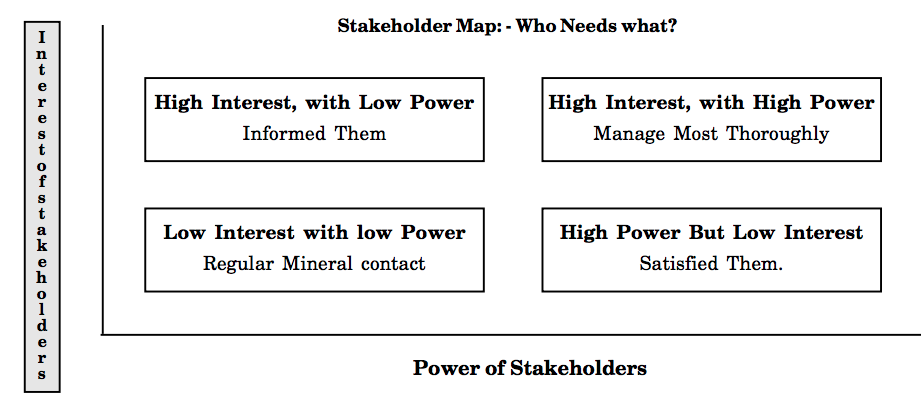Stakeholders Management and Stakeholders Mapping:Recently attended one session ‘Stakeholders Management’ and would like to share some highlights for our ‘stakeholders’. Stakeholders Management is a critical component to the successful delivery of any project, programme or activity. Stakeholder management creates positive relationship with stakeholders through the appropriate management of their expectations and agreed objectives. Stakeholder’s management is a process and control that must be planed and guided by underlying principles
Stakeholders Management and Stakeholders Mapping
Before we go forward it is important to understand the definition of stakeholder.
A person, group or organisation that has interest or concern in an organisation. Stakeholders can affect or affected by the organisations action, objective and policies. Some example of key stakeholders are Creditor, Directors, Employees, Government, Owners, Suppliers, Trade Unions and Community from which the business draws its resource.
Stakeholder Identification:
The first step in your stakeholder analysis is to brainstorm who your stakeholders are. As a part of this, think of all people who are affected by your work, who have influence or power over it, or have an interest in its. Successful or unsuccessful conclusion. Remember that although stakeholder may be both “Organisations” and “People”, ultimately you must communicate with people. Make sure that you identify the correct individual stakeholders within a stakeholder organisation so in a nutshell, the stakeholder management comprises four steps, which are:-
Advertisement
Content in this Article
- A) Identify, recognise and acknowledge stakeholder.
- B) Determine their influence and interest.
- C) Establish communication management plan.
- D) Influencing and engaging stakeholder.
Stakeholder Map: – Who Needs what?

Power of Stakeholders
Above chart is simply explain in following words:-
1) Low Power, High Interest
Treatment: – Inform them.
but very little power to influence it. Anticipate their needs and keep these stakeholder informed to ensure their continued support. Consult on their area of interest and use their input to improve your level of success.
Example: – End Users, Media Outlets
2) High Power, High Interest
Treatment: – Manage them thoroughly
These are your key stakeholders. They have a lot of influence and a strong interest in the outcome. Manage them well to build strong relationship and ensure you retained, their support. Involve them in decision and engage regularly. Example: – Trade Unions, Politicians, Investors.
3) High Power, Low Interest
Treatment: – Satisfy
These are highly influential stakeholders but they don’t have a lot of interest, nor are they actively engaged in your project. Consider their objectives and keep them satisfied. Example: -Regulators, Administrator
4) Low Power, Low Interest
Treatment: – Monitor
These stakeholders sit on the periphery of the project. They are neither interest .Monitor their activity from time to time to stay on top of their involvement. Their relevance may change over a time. Communicate to keep them informed and encourage their interest.
Example: – Support service
“To keep everyone invested in your vision, you have to back up a little bit and really analysis who the different stakeholders are and what they individual respond to.” – Alan Stern
Must Read
